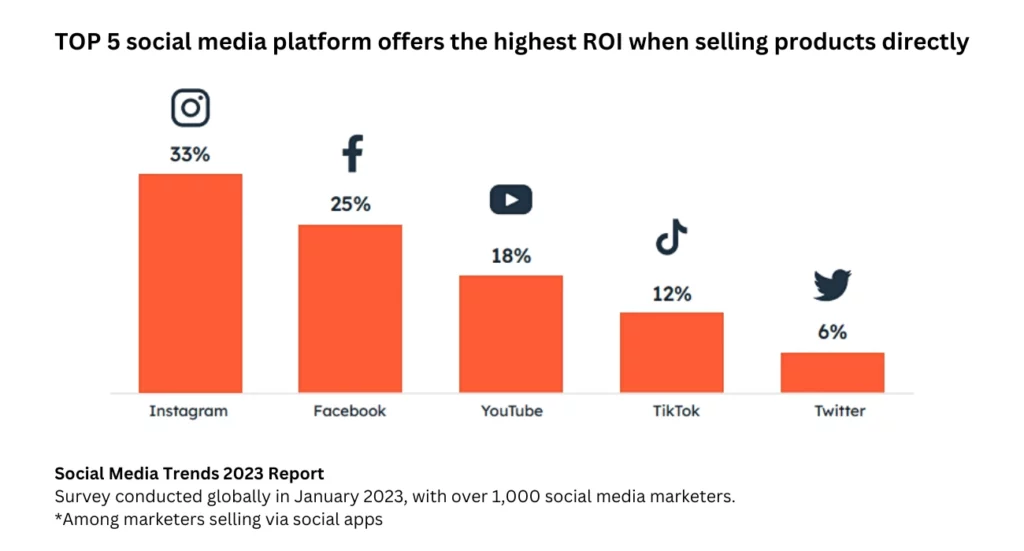Social media marketing strategy has become a cornerstone for business success. With an user base of, over 4.4 billion people on platforms like Facebook, Instagram, X (formerly Twitter) and more the virtual world has become a vibrant hub of connections and endless opportunities.
Developing a Social Media Marketing Strategy is about harnessing the power of these platforms to boost your brand engage with your audience and drive your business objectives forward. From capitalizing on trends, to utilizing targeted ads we’re about to reveal the secrets behind a strategy that will surely make your competitors take notice.
What is Social Media Marketing?
Social media marketing (SMM) involves utilizing social media platforms to establish connections, with your target audience enhance brand recognition and accomplish business goals.
Businesses of all sizes ranging from startups to established enterprises are increasingly realizing the immense potential of social media marketing as a vital weapon, in their marketing strategies.
The capability to directly interact with customers, brand loyalty and boost sales has completely transformed the realm of marketing.
The Five Core Pillars of Social Media Marketing
Social media marketing requires a strategic approach and a well-structured plan to achieve desired outcomes. The five core pillars of social media marketing lay the foundation for a successful strategy that maximizes engagement, brand exposure, and business growth.
Strategy
Strategy is the cornerstone of any effective social media marketing campaign. It involves defining your objectives, understanding your target audience, and outlining the tactics you’ll use to achieve your goals.
A well-crafted strategy provides direction, ensuring that every action you take on social media aligns with your overall business objectives. Your strategy should encompass content themes, posting schedules, and methods for engagement.
- Defining Objectives: Identify what you want to achieve through social media marketing. Whether it’s brand awareness, lead generation, or increased website traffic, your objectives guide your efforts.
- Understanding Your Audience: Deeply understanding your target audience’s preferences, behaviors, and pain points is crucial. Tailor your content to resonate with their interests and motivations.
- Choosing Platforms: Select social media platforms where your audience is most active. Each platform has a unique user base and communication style.
Planning and Publishing
This pillar revolves around the creation, scheduling, and distribution of content across your chosen social media platforms. Consistency is key here; your audience should come to expect regular, high-quality content from your brand. Planning content in advance allows you to maintain a steady stream of posts that align with your strategy.
- Content Calendar: Developing a content calendar helps you organize your posts and maintain a consistent posting schedule. It prevents last-minute scrambles and ensures a cohesive brand message.
- Content Creation: Your content should be relevant, engaging, and valuable to your audience. It can include images, videos, blog posts, infographics, and more.
- Scheduling: Use social media management tools to schedule posts ahead of time. This ensures a consistent presence on your chosen platforms.
Listening and Engagement
Social media is a two-way street. Listening and engagement involves actively monitoring conversations around your brand, responding to comments and messages, and fostering meaningful interactions with your audience.
- Active Monitoring: Keep an eye on mentions of your brand, industry, and relevant keywords. This helps you stay informed about conversations related to your business.
- Timely Responses: Respond promptly to comments, questions, and feedback. This shows your audience that you value their input and are engaged in the conversation.
- Meaningful Interactions: Engage in authentic interactions. Ask questions, spark discussions, and provide valuable insights to create a sense of community around your brand.
Analytics and Reporting
Measuring the effectiveness of your social media efforts is vital to refining your strategy over time. Analytics and reporting allow you to track key performance indicators (KPIs) and gain insights into what’s working and what’s not.
- Key Metrics: Monitor metrics such as engagement rates, reach, clicks, conversions, and follower growth. These metrics provide a clear picture of your strategy’s impact.
- Data Analysis: Regularly analyze the data to identify trends and patterns. Determine which types of content resonate most with your audience and adjust your approach accordingly.
- Refinement: Use insights from your data analysis to fine-tune your strategy. Eliminate or modify tactics that aren’t yielding the desired results and amplify those that are successful.
To know more about Social media analytics and reporting, watch this video provided by Google:
Advertising
While organic reach on social media is valuable, advertising offers a way to amplify your message to a broader, targeted audience. Social media platforms provide robust advertising tools that allow you to customize your audience, budget, and ad format.
- Targeted Ads: Leverage the demographic, geographic, and interest-based targeting options provided by social media platforms. This ensures your ads reach the most relevant audience.
- Ad Creatives: Create compelling ad creatives that align with your brand identity and capture the attention of users scrolling through their feeds.
- Budget Management: Set a budget for your ad campaigns and monitor their performance. Adjust your budget allocation based on the ads that are delivering the best results.
Incorporating these five core pillars into your social media marketing strategy establishes a strong foundation for achieving your business objectives.
By strategically planning, engaging with your audience, analyzing data, and utilizing advertising tools, you’ll not only enhance your brand’s online presence but also drive meaningful results for your business.
Benefits of Social Media Marketing
Increase Brand Awareness
Social media platforms offer unparalleled opportunities to showcase your brand to a vast audience. Through consistent posting and engagement, you can elevate brand recognition and establish a distinct online identity.
Drive Website Traffic
Compelling social media posts can drive traffic to your website, where potential customers can learn more about your products or services. Include links and calls-to-action that guide users to your website.
Build Community with Target Audience
Engaging with your audience on a personal level fosters a sense of community. When customers feel connected to your brand, they are more likely to become loyal advocates and repeat buyers.
Generate Leads and Sales
Strategically placed posts and ads can generate leads by prompting users to sign up for newsletters, download resources, or make purchases. An effective social media strategy nurtures leads through the sales funnel.

How to Build a Social Media Marketing Strategy
Building an effective social media marketing strategy involves a series of practical steps that guide you from setting clear goals to creating engaging content and measuring your success. Let’s break down each step in detail:
1. Set SMART Goals
Specific, Measurable, Achievable, Relevant, and Time-bound (SMART) goals lay the foundation for your strategy. These goals provide a clear direction and help you stay focused on what you want to achieve.
For instance, your goal might be to “Increase brand awareness by 20% among our target audience on Instagram within the next three months.”
2. Identify Your Target Audience
Understanding your audience is crucial. Who are they? What are their interests, needs, and pain points? The more you know about your audience, the better you can tailor your content to resonate with them.
Collect data from your existing customers, conduct surveys, and analyze demographics on social media insights.
To conduct surveys for your target audience, follow these steps:
- Define survey goals: Clarify the information you seek, like preferences or demographics.
- Choose a tool: Opt for tools like SurveyMonkey, Google Forms, etc.
- Craft questions: Use varied formats for diverse insights.
- Select audience: Use screening or demographic filters to reach desired participants.
- Distribute: Share via email, social media, pop-ups, or ads.
- Analyze: Identify patterns and trends in responses.
- Apply findings: Adjust strategies, products, or experiences based on feedback.
3. Choose Social Media Platforms
Not all platforms are created equal. Select the platforms where your target audience is most active. Consider the nature of your content and your audience’s preferences. For example, if your audience is primarily young adults interested in visual content, platforms like Instagram and TikTok might be more suitable.
To pick social media platforms for your business, follow these steps:
- Know Your Audience: Learn who your target audience is and their preferred platforms. Use data, surveys, and research.
- Set Goals: Define your social media goals, like brand awareness or lead generation.
- Study Competitors: Analyze your rivals’ social media strategies for insights.
- Goal and Audience Alignment: Match platforms to your goals and audience. Consider business nature and demographics.
- Data-Driven Decision: Use a document or spreadsheet to list platforms, noting demographics, engagement, and content types.
- Resource Consideration: Assess time, effort, and budget for each platform. Focus on 1-3 that yield the best return.
- Top Platforms: Consider popular business platforms: Facebook, Instagram, LinkedIn, Pinterest, Snapchat, TikTok, Twitter, and YouTube. The specific explanation of Best Social Media Marketing Platforms is in the end of this article.
Read more: Best Live Streaming Platforms in 2023
4. Create Engaging Content
Content is king on social media. Craft content that captures attention, educates, entertains, or solves problems. Use a mix of text, images, videos, and infographics.
Follow the 80-20 rule: 80% of your content should be valuable and informative, while 20% can be promotional.
The 80-20 rule, also known as the Pareto Principle, suggests that 80% of your social media content should be useful, informative, entertaining, or engaging to your audience, while only 20% should be explicitly promotional or focused on your brand.
5. Utilize Paid Social Media Advertising
Paid advertising amplifies your reach and targets specific demographics. Set a budget and experiment with different ad formats to see what resonates best with your audience.
For instance, you could run a Facebook ad campaign targeting users in a specific location and age group to promote a new product launch.
6. Analyze and Adjust Strategy
Regularly monitor your social media analytics to gauge your strategy’s effectiveness. Track metrics like engagement rates, reach, clicks, and conversions.
If you find that posts with visual content receive higher engagement, adjust your strategy to include more visuals.
7. Refine Based on Data
Based on your analysis, refine your strategy. Eliminate tactics that aren’t yielding results and double down on what’s working.
For example, if you notice that your engagement rate is higher on weekdays, shift your posting schedule to focus on those days.
Building a social media marketing strategy requires a mix of careful planning, continuous learning, and adaptability. By setting clear goals, understanding your audience, creating compelling content, utilizing paid advertising, and using data-driven insights, you can develop a strategy that not only boosts your brand’s online presence but also drives meaningful business outcomes.
Read more:
Best Social Media Marketing Platforms
| Social Media Platform | Audience Reach | Key Features | Business Targets |
|---|---|---|---|
| 2.8 billion | Extensive user base, diverse ad formats | B2C, B2B, brand exposure, lead generation, customer service | |
| 1.2 billion | Visual-centric, influencer collaborations | Visual brands, e-commerce, influencer partnerships | |
| 330 million | Real-time updates, trending hashtags | News outlets, trending topics, customer engagement | |
| 774 million | Professional networking, B2B marketing | B2B networking, job recruitment, thought leadership | |
| TikTok | 1.3 billion | Short-form video, viral challenges | Youth-oriented products, creative marketing |
| 460 million | Visual discovery, DIY and lifestyle content | DIY projects, home décor, lifestyle products | |
| YouTube | 2 billion | Video content, tutorials, vlogs | How-to videos, brand storytelling, tutorials |
| Snapchat | 500 million | Ephemeral content, AR filters | Temporary promotions, interactive campaigns |
| 430 million | Niche communities, discussions | Niche markets, focused discussions, community building | |
| 2 billion | Direct messaging, private groups | Customer support, private group communication |
Social Media Marketing Future
Visual focused platforms like Instagram, Pinterest and TikTok are seamlessly blending with ecommerce marketing. They showcase products in settings collaborations between brands and influencers and encourage user generated content (UGC).
Nowadays all major social platforms have integrated ecommerce features. Surprisingly 80% of social media marketers agree that consumers prefer buying within these apps rather than visiting brand websites or using third party platforms such as Amazon.
Brands are quick to grasp this opportunity; currently 47% of social media marketers report that their brands facilitate direct product sales within social media apps. As the connection, between media and ecommerce grows stronger it’s evident that the shopping landscape is undergoing a transformation.
80% of social media marketers have reported that consumers often make purchases within apps surpassing the popularity of purchasing from brand websites or third party resellers.
Brands who aren’t tapping into the power of commerce are truly missing out on an audience that spans across different generations.
It’s worth noting that people, between the ages of 18 and 44 tend to discover products through media and an impressive 35% of Generation Z individuals say that they primarily use social media to stay updated on brands and products.
Read more: What is Social Media Management?
Conclusion
A solid social media marketing strategy is not just a choice; it’s a necessity. The ability to connect with a global audience, amplify brand recognition, and drive tangible results makes it an indispensable tool for businesses of all sizes. By understanding the core pillars, leveraging the benefits, and consistently refining your approach, you can harness the power of social media marketing to succeed in your business endeavors.
FAQ
Is social media marketing suitable for all types of businesses?
Social media marketing can benefit a wide range of businesses, but the strategy will vary based on the industry and target audience. It’s important to tailor your approach to your specific goals and audience.
How can I measure the success of my social media marketing efforts?
Key performance indicators (KPIs) like engagement rate, reach, click-through rate, and conversion rate can help you assess the success of your social media strategy.
Are there any potential downsides to social media marketing?
While social media marketing offers numerous benefits, it requires consistent effort, and negative feedback or crises can spread quickly. Proper management and monitoring are essential.
What role does storytelling play in social media marketing?
Storytelling humanizes your brand and creates an emotional connection with your audience. Sharing relatable stories can enhance engagement and brand loyalty.
How can I stay updated with the latest social media marketing trends?
Following industry blogs, attending webinars, and participating in relevant online communities can help you stay informed about the latest trends and updates in social media marketing.








